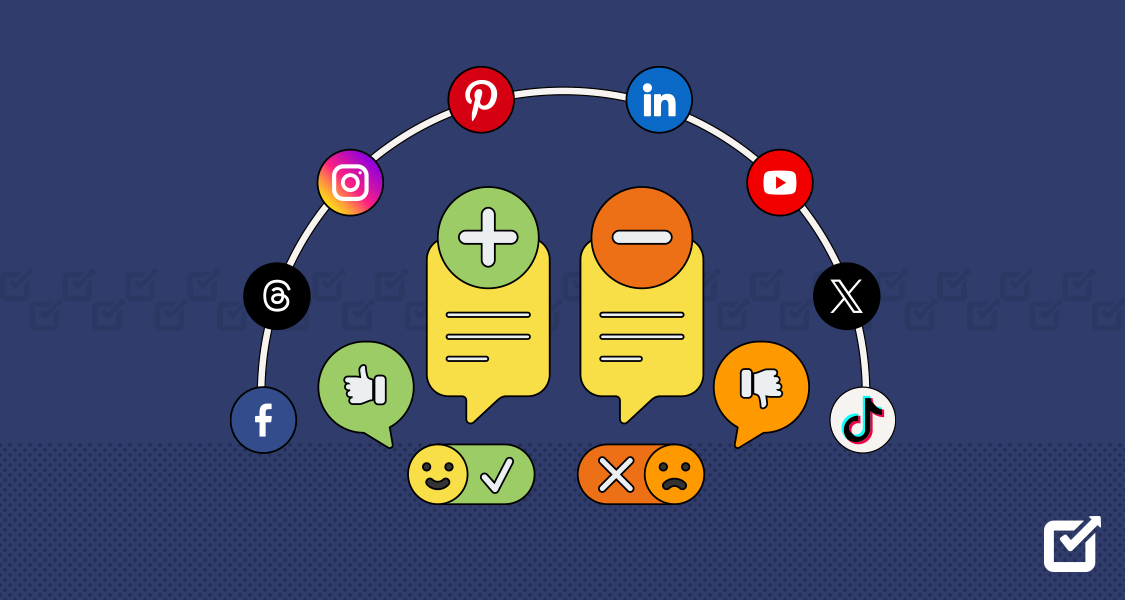Setting and completing goals is essential for businesses and individuals to succeed in today’s fast-paced social media world. Every year, platforms launch new features, algorithms change, and trends appear; therefore, adjusting and planning wisely is essential.
A well-defined plan is essential for your social media goals, as it can increase engagement, drive sales, or improve your online presence.
Having clear objectives of what you want to achieve, along with efficient tools, can take your social media strategy to the next level. For example, you can use a social media scheduler to automate your online presence across various platforms. Using a scheduler, you can plan and schedule your posts in advance, ensuring a consistent and timely presence with no constant manual posting.
With features like post scheduling, content calendar organization, and analytics tracking, social media schedulers streamline your workflow, allowing you to focus on creating engaging content and engaging with your audience.
Want to know in detail how to achieve smart goals for social media in 2024? Let’s dive into it.
What Are Social Media Goals?
Social media goals are specific objectives that individuals or businesses aim to achieve through their presence and activities on social media platforms. These goals provide direction, focus, and a measurable framework for assessing the effectiveness of social media efforts. Here’s a detailed breakdown of common social media goals:
Increase Brand Awareness: One of the primary goals for many businesses is to increase brand visibility and recognition among their target audience. This could involve growing the number of followers, increasing shares and mentions, and generating buzz around your brand.
Drive Website Traffic: Social media can be a powerful tool for driving traffic to your website or blog. Whether you’re promoting new content, products, or services, increasing website traffic through social media can lead to higher conversions and engagement.
Support Business Goals: Ultimately, social media goals should align with broader business objectives, such as increasing revenue, expanding market reach, launching new products, or entering new markets. Organizations can maximize impact and drive measurable results by aligning social media efforts with overarching smart social media goals.
Uplift Your Social Media Game Through Social Champ
What are you waiting for? Use this tool to build a strong social media marketing strategy for your brand!
Why Do Social Media Goals Matter?
Social media goals are fundamental to the success of any social media marketing goal. They provide direction and a framework for measuring progress and effectiveness. Here’s a detailed exploration of why social media goals matter:
Strategic Alignment
- Goals ensure social media efforts align with broader business objectives.
- You can establish specific goals that contribute to organizational aims.
- Align social media marketing goals with the company’s mission, vision, and values.
- Coordinate with other departments to integrate social media goals with overall marketing strategies.
- Regularly review and adjust social media goals to align with evolving business priorities.
Measurable Outcomes
- Define clear metrics and key performance indicators (KPIs) for each social media goal.
- Track metrics, such as engagement, click-through, conversion, and ROI.
- Use analytics tools to monitor progress and measure the impact of social media efforts.
- Set benchmarks and targets for desired outcomes to assess success.
- Regularly analyze data to identify trends, patterns, and areas for improvement.
Focus and Prioritization
- Prioritize social media goals based on their alignment with business priorities.
- Focus on activities with the most significant potential to drive results and achieve objectives.
- Allocate resources to high-priority goals, including time, budget, and personnel.
- Avoid spreading efforts too thin by concentrating on a few key goals at a time.
- Regularly reassess the goals of social media and adjust priorities to focus on what matters most.
Accountability
- Clearly define roles, responsibilities, and expectations for team members involved in social media.
- Establish regular check-ins and reporting mechanisms to track progress toward goals.
- Hold individuals accountable for their contributions to goal achievement.
- Encourage transparency and open communication within the team to address challenges and obstacles.
- Celebrate successes and acknowledge efforts to maintain motivation and accountability.
Optimization and Improvement
- Continuously expand the performance of social media campaigns and initiatives.
- Identify areas of success and areas for improvement based on data analysis.
- Experiment with different strategies, tactics, and content formats to optimize results.
- Implement A/B testing to determine the most effective approaches for achieving goals.
- Regularly review and refine the goals of social media and strategies to adapt to changing market conditions and audience preferences.
10 Results-Driven Social Media Goals.
Social media marketing goals are crucial for businesses and individuals to succeed in their online marketing efforts.
Increase Brand Awareness
- Expand the reach and visibility of your brand to attract a larger audience and improve brand recognition.
- Focus on growing your social media following, increasing shares and mentions, user-generated content, and running targeted brand awareness campaigns.
- Track metrics, such as reach, impressions, brand mentions, follower growth rate, and share of voice to measure brand awareness.

A snapshot of Instagram Boost Engagement
- Foster meaningful interactions with your audience to build a loyal community and increase brand affinity.
- Create engaging content, ask questions, encourage comments and shares, respond promptly to audience inquiries, and host interactive live or Q & A Sessions.
- Measure engagement metrics, including likes, comments, shares, retweets, replies, and overall engagement rate to assess audience interaction and participation.
Drive Website Traffic
- Direct traffic to your website or landing pages to increase leads, conversions, and sales.
- Share links to your website content, blog posts, product pages, or special offers on social media platforms, utilize call-to-action buttons and track referral traffic using web analytics tools.

- Monitor website traffic metrics such as clicks, click-through rate (CTR), bounce rate, session duration, and conversion rate to evaluate the effectiveness of your social media traffic.
Generate Leads
- Capture leads and grow your email list to nurture prospects and drive sales.
- Offer valuable content or resources for email sign-ups, promote gated content, run lead generation ads, and use forms on social media platforms.
- Track lead generation metrics, such as leads captured, conversion rate, cost per lead (CPL), and lead quality to assess the success of your lead generation efforts.
Increase Sales
- Drive revenue by promoting products or services through social media channels.
- Showcase product features, benefits, and customer testimonials; run product launch campaigns, offer exclusive discounts or promotions, and provide seamless purchasing experiences through social commerce features.
- Measure sales metrics, including conversion rate, revenue generated, average order value (AOV), and return on ad spend (ROAS), to evaluate the impact of your social media sales initiatives.
Improve Customer Service:
- Enhance customer satisfaction and loyalty by providing timely support and addressing customer inquiries or issues on social media.
- Monitor social media mentions and messages, respond promptly to customer inquiries and feedback, resolve customer complaints or concerns, and provide helpful resources or solutions.

- Track customer service metrics, such as response time, resolution time, customer satisfaction (CSAT) scores, and sentiment analysis to gauge the effectiveness of your social media customer support efforts.
Build Thought Leadership
- Establish yourself or your brand as an authority in your industry or niche to attract followers, gain credibility, and influence opinions.
- Share valuable insights, industry trends, and expertise through educational content, thought-provoking articles, whitepapers, webinars, and speaking engagements, engage in industry conversations, and collaborate with influencers or experts.
- Measure thought leadership metrics such as thought leadership index, share of voice in industry discussions, engagement with thought leadership content, and brand sentiment to assess your influence and credibility.
Cultivate Brand Loyalty
- Foster a strong emotional connection with your audience to encourage repeat purchases, referrals, and advocacy.
- Reward loyal customers with exclusive offers, discounts, or loyalty programs, provide personalized experiences, showcase user-generated content and customer testimonials, and engage in two-way communication to show appreciation and build trust.
Monitor Brand Reputation
- Protect and enhance your brand’s reputation by actively listening to feedback, addressing issues, and amplifying positive sentiment on social media.
- Monitor social media mentions, reviews, and comments; respond promptly to customer feedback and complaints; address negative sentiment with transparency and empathy; and highlight positive customer experiences and testimonials.
- Measure brand reputation metrics, including sentiment analysis, brand sentiment score, online reviews and ratings, and brand mentions, to assess the overall perception of your brand and identify areas for improvement.
Gain Market Insights
- Gather valuable insights into customer preferences, behaviors, and trends to inform strategic decision-making and marketing strategies.
- Analyze social media metrics, audience demographics, and engagement patterns; conduct social listening to monitor conversations and sentiment about your brand and industry; and use surveys, polls, and focus groups to gather feedback from your audience.
- Track market insights metrics, such as audience demographics, sentiment analysis, trending topics, content performance, and competitive analysis, to uncover valuable insights and opportunities for optimization and innovation.
Related Article: 15+ Best Customer Service Software for Social Media Management in 2024
How to Set Social Media Goals for Your Business
Setting a goal for social media is critical in creating an effective social media strategy that aligns with your objectives and drives meaningful results. Here’s a detailed guide on “How do you set social media goals?”
- Understand Your Business Objectives: Before diving into setting social media goals, it’s essential to have a clear understanding of your broader business objectives. These include increasing sales, expanding market reach, launching new products, enhancing brand awareness, improving customer service, or building thought leadership in your industry.
- Identify Key Performance Indicators (KPIs): Once you’ve established your business objectives, identify the key metrics or KPIs that will indicate progress towards those Goals. For example, if your goal is to increase sales, relevant KPIs include website traffic, lead generation, conversion rate, and revenue generated from social media channels.
- Conduct a Social Media Audit: Assess your current social media presence and performance to identify strengths, weaknesses, opportunities, and threats. Analyze follower growth, engagement rates, content performance, audience demographics, and competitor benchmarks to gain insights into improvement areas and growth opportunities.
- Set Specific and Measurable Goals: Based on your business objectives and KPIs, establish specific and measurable social media goals that you aim to achieve within a defined timeframe. For example, if your objective is to increase brand awareness, a particular goal could be to grow your Instagram following by 20% within six months.
- Use the SMART Framework: Ensure that your social media goals are SMART: Specific, Measurable, Achievable, Relevant, and Time-bound. This framework helps clarify objectives, track progress, and ensure that goals are realistic and aligned with your overall strategy.
- Prioritize Goals Based on Impact: Depending on your business priorities and resources, prioritize your social media goals based on their potential impact on your overall objectives. Focus on goals most significantly impacting business results and allocate resources accordingly.
- Diversify Your Goals: While focusing on goals directly related to your business objectives is essential, consider diversifying your goals to cover different aspects of social media performance. These could include goals related to brand awareness, audience engagement, lead generation, customer service, reputation management, and market insights.
- Break Down Goals into Actionable Steps: Once you’ve established your smart goals for social media, break them down into actionable steps and strategies. Identify specific tactics, campaigns, content types, posting schedules, and audience-targeting strategies that will help you reach your goals effectively.
- Monitor Progress and Adjust Strategies: Continuously monitor your progress towards your goals for social media using analytics tools and performance metrics. Track critical indicators regularly, analyze trends, and adjust your strategies and tactics to stay on track and optimize your results.
- Celebrate Milestones and Learn from Challenges: Celebrate achievements and milestones as you progress towards your social media goals, and use setbacks or challenges as opportunities for learning and improvement. Reflect on what worked well, what didn’t, and how you can adjust your approach to continue progressing toward your objectives.
By following these steps and best practices, you can set meaningful social media goals for your business that align with your objectives, drive measurable results, and contribute to your long-term success in the digital world.
Tools and Resources to Support Your Social Media Goals
Social media has become famous for marketing strategies for businesses and brands. With billions of active users on platforms like Facebook, Instagram, Twitter, and more, social media provides an unparalleled opportunity to connect with your target audience.
However, more than having a presence on social media alone is required. You need to have clear goals and employ the right tools and resources to achieve those goals effectively. Let’s find some amazing tools and resources for social media engagement.
Tools to Increase Engagement
Engagement on social media is critical for building relationships with your followers. Some helpful tools to boost engagement include:
- Social Champ- Allows scheduling of posts in advance, and provides an AI-powered best time to post feature that allows you to publish at optimal times when followers are most active. Its analytics help track engagement.
- Hootsuite – This enables managing multiple social profiles and scheduling posts. Features like streams help monitor engagement.
- BuzzSumo – Helps discover trending content and viral posts for your industry for benchmarking and getting content ideas.
- Talkwalker – Social media listening tool to identify relevant conversations and your brand mentions. Allows engaging with followers and prospects.
Content Tools
Creating high-quality, engaging content is crucial for social media success. Some content creation tools are:
- Canva is an easy-to-use graphic design and content creation tool with numerous templates. Allows creating visually appealing posts.
- Venngage – Infographic and visual content creation service to produce engaging posts that get attention.
- Champ AI Suite – Creates simple yet effective social media images and quotes. Easy to produce content quickly.
- com- is a video creation platform for making professional-quality short brand videos for social advertising.
Analytics Tools
Analytics tools provide insights into how your social media efforts are performing. Some top options are:
- Social Champ- Provides detailed analytics on page growth, engagement, best times to post, and more, across profiles.
- Iconosquare – Instagram-specific analytics to track follower growth, engagement rates, and more, to optimize Instagram strategy.
- Facebook Analytics – Native Instagram and Facebook analytics for page performance. Metrics on reach, engagement and audience.
Advertising Platforms
Social platforms provide advanced advertising capabilities to help reach more of your relevant audience.
- Facebook Ads Manager – Provides detailed targeting, flexible bidding, and budgeting for effective Facebook and Instagram ads.
- LinkedIn Campaign Manager – Allows creating and optimizing Sponsored Content, Message Ads, and more to reach the professional audience.
- Twitter Ads – Enables promoted tweets, trends, and account targeting to scale Twitter advertising.
Conclusion
Setting and achieving social media goals in 2024 requires a strategic approach, adaptability, and a focus on delivering value to your audience. By understanding your business objectives, identifying key performance indicators, conducting thorough audits, and setting SMART goals, you can establish a clear roadmap for success on social media.
It’s essential to see the social media goals examples that align with your business priorities, diversify your objectives to cover various aspects of social media performance, and continually monitor progress to make necessary adjustments. With dedication, creativity, and a commitment to excellence, businesses and individuals can leverage social media to drive brand awareness, engagement, leads, sales, and overall business growth in 2024 and beyond.
Frequently Asked Questions
1. What Are the Three Main Goals of Social Media?
2. Which Type of Social Media Goal Is Best for My Business?
However, if you’re an e-commerce business aiming to drive sales, prioritizing goals related to lead generation, conversion rate optimization, and revenue generation would be more appropriate.












